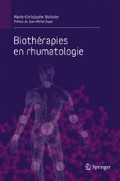Résumé
Les cellules Stromales mésenchymateuses (MSC) ont un potentiel thérapeutique dans le domaine de la rhumatologie, avant tout sur la base de leur potentiel de différenciation en cartilage ou en tissu osseux, aujourd’hui en partie éclipsé par leur capacité à prévenir la fibrose et l’inflammation articulaire (1). Les MSC semblent être les meilleurs candidats pour la thérapie cellulaire afin de régénérer les tissus lésés, car ils sont facilement isolés à partir de la moelle osseuse (BM) ou le tissu adipeux et peuvent être rapidement amplifiés pour un usage thérapeutique (2, 3). Certaines questions restent toutefois en suspens, dont l’origine des MSC et la similitude entre les synoviocytes et les MSC. En outre, les interactions entre MSC et cellules immunitaires présentent un intérêt potentiel dans le cadre d’applications cliniques pour les maladies inflammatoires.
Preview
Unable to display preview. Download preview PDF.
Références
Dominici M, Le Blanc K, Mueller I et al. (2006) Minimal criteria for defining multipotent mesenchymal stromal cells. The International Society for Cellular Therapy Position Statement. Cytotherapy 84: 315–7
Pittenger MF, Mackay AM, Beck SC et al. (1999) Multilineage potential of adult human mesenchymal stem cells. Science 284:143–7
Gimble JM, Katz AJ, Bunnell BA (2007) Adipose-derived stem cells for regenerative medicine. Circ Res 1009:1249–60
Jorgensen C, Djouad F, Bouffi C, Mrugała D, Noel D (2008) Multipotent mesenchymal stromal cells in articular diseases. Best Pract Res Clin Rheumatol 222:269–84
Djouad F, Bony C, Haupl T et al. (2005) Transcriptional profiles discriminate bone mar-rowderived and synovium-derived mesenchymal stem cells. Arthritis Res Ther 76:R1304–15
Noel D, Caton D, Roche S et al. (2008) Cell specific differences between human adipo-sederivedand mesenchymal-stromal cells despite similar differentiation potentials. Exp Cell Res 314:157–8
Muraglia A, Cancedda R, Quarto R (2000) Clonal mesenchymal progenitors from human bone marrow differentiate in vitro according to a hierarchical model. J Cell Sci 113 (Pt 7): 1161–6
Sacchetti B, Funari A, Michienzi S et al. (2007) Self-renewing osteoprogenitors in bone marrow sinusoids can organize a hematopoietic microenvironment. Cell 1312: 324–36
Zuk PA, Zhu M, Mizuno H et al. (2001) Multilineage cells from human adipose tissue: implications for cell-based therapies. Tissue Eng 72:211–28
Planât-Benard V, Silvestre JS, Cousin B et al. (2004) Plasticity of human adipose lineage cells toward endothelial cells: physiological and therapeutic perspectives. Circulation 1095: 656–63
Mazo M, Planât-Benard V, Abizanda G étal. (2008) Transplantation of adipose derived stromal cells is associated with functional improvement in a rat model of chronic myocardial infarction. Eur J Heart Fail 105: 454–62
Rehman J, Traktuev D, Li J et al. (2004) Secretion of angiogenic and antiapoptotic factors by human adipose stromal cells. Circulation 10910:1292–8
Fickert S, Fiedler J, Brenner RE (2003) Identification, quantification and isolation of mesenchymal progenitor cells from osteoarthritic synovium by fluorescence automated cell sorting. Osteoarthritis Cartilage 1111: 790–800
Hiraoka K, Grogan S, Olee T, Lotz M. (2006) Mesenchymal progenitor cells in adult human articular cartilage. Biorheology 433-4:447–54
Alsalameh S, Amin R, Gemba T, Lotz M. (2004) Identification of mesenchymal progenitor cells in normal and osteoarthritic human articular cartilage. Arthritis Rheum 505:1522–32
Noel D, Djouad F, Bouffi C, Mrugała D, Jorgensen C (2007) Multipotent mesenchymal stromal cells and immune tolerance. Leuk Lymphoma 487:1283–9
Ren G, Zhang L, Zhao X et al. (2008) Mesenchymal stem cell-mediated immunosuppression occurs via concerted action of chemokines and nitric oxide. Cell Stem Cell 22:141–50
Liu CH, Hwang SM (2005) Cytokine interactions in mesenchymal stem cells from cord blood. Cytokine 326:270–9
Pevsner-Fischer M, Morad V, Cohen-Sfady M. et al. (2007) Toll-like receptors and their ligands control mesenchymal stem cell functions. Blood 1094:1422–32
Liotta F, Angeli R, Gosmi L et al. (2008) Toll-like receptors 3 and 4 are expressed by human bone marrow-derived mesenchymal stem cells and can inhibit their T-cell modulatory activity by impairing Notch signaling. Stem Cells 261:279–89
Jones S, Horwood N, Cope A, Dazzi F (2007) The antiproliferative effect of mesenchymal stem cells is a fundamental property shared by all stromal cells. J Immunol 1795:2824–31.
Djouad F, Fritz V, Apparailly F et al. (2005) Reversal ofthe immunosuppressive properties of mesenchymal stem cells by tumor necrosis factor alpha in collagen-induced arthritis. Arthritis Rheum 525:1595–603
Augello A, Tasso R, Negrini SM, Cancedda R, Pennesi G (2007) Cell therapy using allogeneic bone marrow mesenchymal stem cells prevents tissue damage in collagen-induced arthritis. Arthritis Rheum 564:1175–86
Zappia E, Casazza S, Pedemonte E et al. (2005) Mesenchymal stem cells ameliorate experimental autoimmune encephalomyelitis inducing T-cell anergy. Blood 1065:1755–61.
Roord ST, de Jager W, Boon L et al. (2008) Autologous bone marrow transplantation in autoimmune arthritis restores immune homeostasis through CD4 + CD25 + Foxp3 + regulatory T cells. Blood 11110: 5233–41
González MA, Gonzalez-Rey E, Rico L, Büscher D, Delgado M. (2009) Treatment of experimental arthritis by in ducing immune tolerance with human adipose-derived mesenchymal stem cells. Arthritis Rheum 60:1006–19
Raghunath J, Salacinski HJ, Sales KM, Butler PE, Seifalian AM (2005) Advancing cartilage tissue engineering: the application of stem cell technology. Curr Opin Biotechnol. Oct; 16: 503–9
Vinatier C, Mrugała D, Jorgensen C et al. (2009) Cartilage engineering: a crucial combination of cells, biomaterials and biofactors. Trends Biotechnol 27: 307–14.
Rights and permissions
Copyright information
© 2011 Springer-Verlag France, Paris
About this chapter
Cite this chapter
Jorgensen, C. (2011). Les cellules Stromales: un futur thérapeutique des maladies ostéo-articulaires. In: Biothèrapies en rhumatologie. Springer, Paris. https://doi.org/10.1007/978-2-8178-0124-7_13
Download citation
DOI: https://doi.org/10.1007/978-2-8178-0124-7_13
Publisher Name: Springer, Paris
Print ISBN: 978-2-8178-0123-0
Online ISBN: 978-2-8178-0124-7

